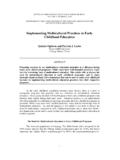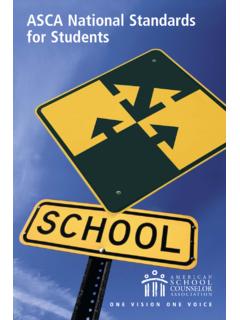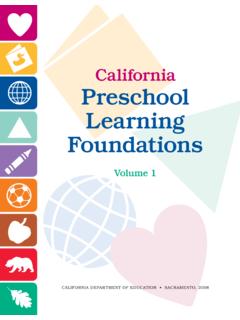Transcription of PHYSICAL EDUCATION TEACHER EVALUATION TOOL
1 PHYSICAL EDUCATION TEACHER EVALUATION TOOL. Introduction The national association for Sport and PHYSICAL EDUCATION (NASPE), the preeminent national authority on PHYSICAL EDUCATION and a recognized leader in sport and PHYSICAL activity, has origins that date back to 1885. A central aspect of this leadership is the development of national standards, guidelines, and position statements that set the standard for quality PHYSICAL EDUCATION programs. Quality PHYSICAL EDUCATION requires appropriate infrastructure (opportunity to learn), meaningful content defined by curriculum, appropriate instructional practices including good classroom management, student and program assessment, and EVALUATION .
2 All teachers benefit from meaningful, ongoing assessment and EVALUATION . The NASPE- developed PHYSICAL EDUCATION TEACHER EVALUATION Tool identifies the knowledge, skills, and behaviors needed to provide sound instruction in the K-12 PHYSICAL EDUCATION classroom. Its purpose is to assist principals, school district curriculum specialists, and others who evaluate PHYSICAL EDUCATION teachers as well as to guide PHYSICAL EDUCATION teachers in reflection and self- assessment, and serve as an instructional tool in college/university PHYSICAL EDUCATION TEACHER EDUCATION programs. Specific examples of how this tool can be used include.
3 Specific Uses for This Tool K-12 Administrator Prioritize and rearrange the items on the EVALUATION tool to emphasize certain teaching knowledge/skills/behaviors Modify the tool to meet needs for formative or summative observation and feedback Customize the tool to target areas identified in a professional growth plan School District Curriculum Specialist Assist teachers with using the tool for professional growth Provide in-service programs to help teachers address point of emphasis or areas of needed improvement Incorporate the tool into the mentoring program for new teachers Use the tool for formal or informal observation of teachers K-12 PHYSICAL EDUCATION TEACHER Use the tool for self-assessment ( , videotape a lesson and review).
4 Study and prioritize the list of tool items to work on specific points of emphasis during instruction Ask a colleague to observe a class and complete the EVALUATION tool for peer feedback 1. College/University PHYSICAL EDUCATION TEACHER EDUCATION Programs Use the tool to teach program candidates about critical instructional skills, for discussion and practice purposes Make the tool available to program candidates for reflection and self-assessment in practical experiences Utilize the tool as part of the student teaching process EVALUATION Principles The following principles serve as guidelines for conducting observations and evaluations of PHYSICAL EDUCATION teachers and are strongly encouraged by NASPE.
5 PHYSICAL educators should: Be evaluated with standards, expectations, procedures, and rigor that parallel teachers of other curricular areas. Be observed, assessed, and evaluated by trained evaluators. Be observed multiple times during the academic year. Be observed for the entire class period, from beginning to end. Be observed and evaluated as part of a comprehensive assessment plan, which should include formal conferences, professional growth plans, etc. Be accountable for student achievement of state standards in PHYSICAL EDUCATION or the national Standards for PHYSICAL EDUCATION (NASPE, 2004) in the absence of state standards.
6 national Standards for PHYSICAL EDUCATION 1: Demonstrates competency in motor skills and movement patterns needed to perform a variety of PHYSICAL activities. 2: Demonstrates understanding of movement concepts, principles, strategies, and tactics as they apply to the learning and performance of PHYSICAL activities. 3: Participates regularly in PHYSICAL activity. 4: Achieves and maintains a health-enhancing level of PHYSICAL fitness. 5: Exhibits responsible personal and social behavior that respects self and others in PHYSICAL activity settings. 6: Values PHYSICAL activity for health, enjoyment, challenge, self-expression, and/or social interaction.
7 Prior to observing a PHYSICAL EDUCATION class/ TEACHER , NASPE requests that you review its online guidelines, Appropriate Practices for PHYSICAL EDUCATION , which are available for early childhood, elementary school, middle school, and high school at: These booklets describe PHYSICAL EDUCATION practices that are in the best interest of children. They address curriculum design, learning experience, fitness activities, fitness testing, assessment, participation levels, forming groups, competition, and much more. 2. Resources for Additional Information Visit the NASPE position statement: What Constitutes a Highly Qualified PHYSICAL EDUCATION TEACHER ?
8 Go to: Other key NASPE publications can be found at , under Publications, in the Online Store, or call 1-800-321-0789 to order your copy: national Standards for PHYSICAL EDUCATION , 2nd Edition (2004). national Standards for Beginning PHYSICAL EDUCATION Teachers (2003). Opportunity to Learn Standards for Elementary School PHYSICAL EDUCATION (2000). Opportunity to Learn Standards for Middle School PHYSICAL EDUCATION (2004). Opportunity to Learn Standards for High School PHYSICAL EDUCATION (2004). Appropriate Practices for Elementary School PHYSICAL EDUCATION (2000). Appropriate Practices for Middle School PHYSICAL EDUCATION (2001).
9 Appropriate Practices for High School PHYSICAL EDUCATION (2004). July 2007. national association for Sport and PHYSICAL EDUCATION , an association of the American Alliance for Health, PHYSICAL EDUCATION , Recreation and Dance 3. PHYSICAL EDUCATION TEACHER EVALUATION Instrument The following chart provides a five-level scoring guide and a selection of descriptive terms to use in an EVALUATION . When giving feedback, provide a number in the rating column adjacent to the statement. Use N/A if the statement is not applicable to this observation. Comment sections can be added under each statement or, as provided, under each broad section.
10 Provide identifying information as necessary for records. Customize for specialized uses. 5 4 3 2 1. Outstanding Above Average Satisfactory Below Average Unsatisfactory Mastery Proficient Basic Needs Unacceptable Improvement Clearly exceeds Strong Meets standard Developing Does not meet standards standards Exemplary Very good Good Poor Needs significant attention TEACHER 's name _____. Evaluator's name _____. Date _____ Class observed _____. F = Formative S = Summative 1. Instruction Rating a. Instruction is based on local, state and/or national PHYSICAL EDUCATION standards b. Supports school improvement goals c.















